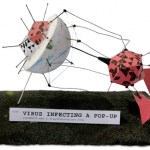Science
Remember the synthetic biology documentary I blogged about a while back? Well, the filmmakers are still working toward their goal. They have a little less than a month left, and I just noticed that they've seriously beefed up the rewards you can get for funding them. There are some interesting gifts from $10 up, but now at $300$1000*, they will send you a rough cut, solicit your input, and credit you in the final version. For everyone concerned about how scientists appear in the film, this is an intriguing option!
*Correction -the cost is actually $1000. For some reason Kickstarter bins all…
The "peer reviewers get worse" item in this morning's Links Dump drew an immediate comment elsewhere to the effect of "of course they do, because they start pawning reviews off on their students. This one was a surprise to me, so here's a quick poll to see if my subfield of physics is really that much more collegial and ethical than the rest of science:
Handing a referee report for a grant or paper off to be written by a grad student or post-doc is:customer surveys
Refereeing takes place via classical communications channels, so you may only choose one option.
My experience is that while I…
"Association, juxtaposition, metaphor is how the poet can go further than the scientist in addressing systems. The poet can legitimately juxtapose kelp beds with junkyards. Or to get really technical, reflect the water reservoir system for a large city in the linguistic structure of repetitive water-associated words in a poem. And poets right now are the only scientist-artists who can do these sorts of associations and get away with them--all other disciplines, such as biology, oceanography, mathematics are obligated to separate their ideas into discrete topics. You're not really allowed to…
Nicely done: Ethan Siegel explains how we know that stuff is getting spontaneously created all the time. It's no miracle, it requires no magic man in the sky, particle/anti-particle pairs just pop into existence constantly.
The real miracle would be getting William Lane Craig to comprehend this fact.
I make an effort to say nice things about pop-science books that I read, whether for book research or blog reviews. Every now and then, though, I hit a book that has enough problems that I have a hard time taking anything positive from it.
I got David Bodanis's E=mc2: A Biography of the World's Most Famous Equation from Union's library because I like the subtitle, and plan to reference it in the relevant chapter of the book-in-progress. I figured that, if I'm going to swipe his subtitle, I should at least be able to say something substantive about the book.
Bodanis takes pains to say that…
Pinkies
from Food Chain: Encounters Between Mates, Predators and Prey by Catherine Chalmers
Photographer Catherine Chalmers (who may be best known in biology circles for her portraits of genetically modified mice) goes beyond brutal accuracy in her animal photography. Food Chain: Encounters Between Mates, Predators and Prey is a book of photos depicting predatory insects, frogs, and snakes devouring their living meals - including naked, squirming baby mice (above). It's no more than honest about what animals do and eat (yes, "cute" frogs will eat baby mice). But Chalmers' ordering and…
Dark pictures, thrones, the stones that pilgrims kiss,
poems that take a thousand years to die
but ape the immortality of this
red label on a little butterfly.
- excerpt from Vladimir Nabokov's "On Discovering a Butterfly"
It's not very well known that novelist Vladimir Nabokov, author of Lolita, was also a lepidopterist; for six years, he was a Research Fellow at the Harvard Museum of Comparative Zoology (now part of the HMNH). Carl Zimmer recounts in the NYT how Harvard professor Naomi Pierce recently set out to test Nabokov's hypotheses about blue butterfly speciation, and discovered…
An invitation from scienceforcitizens.net:
As record levels of snow blanket much of the United States this year, Science For Citizens is collaborating with an important climate research project at the University of Waterloo called Snow Tweets. We're pleased that this is the first of many scientific projects that you'll be able to do on Science for Citizens.
To help researchers track climate change, we're requesting that you find a ruler, put on a warm coat, go outside, and measure the depth of snow wherever you happen to be. And then report the depth to us right here. That's all there is to…
I probably ought to get a start on the big pile of grading I have waiting for me, but I just finished a draft of the problematic Chapter 7, on E=mc2, so I'm going to celebrate a little by blogging about that.
One thing that caught my eye in the not-entirely-successful chapter on momentum and energy in An Illustrated Guide to Relativity was a slightly rant-y paragraph on how it's misleading to talk about the energy released in nuclear reactions as being the conversion of mass into energy, because what's really involved is just the release of energy due to the strong force. It struck me as…
Subtitled "Understanding Einstein's Relativity," David Mermin's It's About Time is another book (like An Illustrated Guide to Relativity) that grew out of a non-majors course on physics that Mermin offers at Cornell. It's also an almost-forty-years-later update of an earlier book he wrote on the same subject. And it's been a really good resource for writing the book-in-progress, which I ought to repay by reviewing it here.
Like the Illustrated Guide, this is a book that aims to teach students something about how relativistic kinematics actually works. Unlike the Illustrated Guide though, this…
I've been playing a bit with the alpha of Qwiki, a new website that offers users an innovative "information experience." The site collects images, videos, and text about topics from the internet and then displays the images future-aesthetically while reading the information in a delightful robot voice. There are still some kinks to work out, but overall it's kind of cute and fun! Here is Qwiki Science:
And Qwiki Science Heroes--Carl Sagan:
Just like on wikipedia, it's easy to fall into a procrastination spiral clicking on related links, but it's worth signing up and poking around!
I think DNA is amazing. I think biotech inspires great design. And if you've read this blog at all, you know I love sciart. But I just cannot understand the new infogenetics product from DNA 11 - the company behind that trendy gel electrophoresis wall art. While I'd normally just say "I don't get it" and move on, DNA 11 claims that their "augmented art" is "the ultimate intersection of biology, art and technology." I don't know how that could get more squarely in the BioE wheelhouse. So let's take a closer look at how, exactly, biology and art intersect in the "Ancestry Portrait" (pictured…
Over in locked LiveJournal land, I read a post talking about computer science education, and how it's biased against people who aren't already tech geeks coming into college:
Taking an intro CS course if you don't already know how to program is like taking intro Spanish without ever having taken it in high school - 90% of the people in that class are ahead of you, possibly way ahead of you, on day one, and you're working from the back.
That is a brutal situation to be in, honestly, and it does nobody any favours. The people who don't already know how to program are dealt a crushing blow to…
I've on occasion been asked why I even bother responding to the brain--and I do use the term loosely--droppings of Mike Adams, the purveyor of one of the largest repositories of quackery on the entire Internet. Good question. Sometimes I wonder that myself. After all, Adams is so far out there, so beyond the realm of rational thought, so full of bizarre conspiracy theories and defenses of quackery that anyone the least bit rational and science-based should be able to see through his nonsense. Applying a heapin' helpin' of not-so-Respectful Insolence to someone as reality-challenged as Mike…
From NextNature, an intriguing post about the Institute for Digital Biology:
During the exhibition, visitors were able to feed a colony of microscopical pop-up creatures, save Chinese websites from a pageview-shortage, preserve an Amazone tribe from extinction by subscribing to its homepage and view a short documentary on how the living internet established itself.
Artist Walewijn den Boer also created a peculiar, twelve-minute faux-documentary, which uses animation to bring his digital biology concepts into meatspace (check it out below the fold).
Update 1:
I think the clunkiness of the…
I got a very nice email today from Sam Gaty, one of the filmmakers behind the Synthetic Biology Documentary I blogged about earlier. He acknowledged the "mad scientist" type concerns, but emphasized that's not what they're going for in the final documentary, and suggested I share another short clip. This one is far more, I don't know how to describe it, techno-chic?
I can definitely see that sort of presentation getting kids interested in biology. It spins bench science as something intriguing, cutting edge, maybe a little hipster. Framing really is all in the aesthetics, isn't it?
Check…
That's what I do, after all. I strongly criticized his uncritical analysis of a set of rape-related evolutionary psychology studies, and now he responds with a rebuttal. It's not a very good rebuttal, but I highly recommend his second paragraph in which he lists a good collection of links to several people who also ripped into his article. That part is excellent!
But then let's get into the part where he argues with me.
P.Z. Myers is not, of course, the undisputed public ambassador of his discipline (although I've no doubt he sees himself as such), and by no means does the following apply to…
So I'm all in favor of promoting struggling artists, and that includes documentary filmmakers. But I have to say I'm a little taken aback by the aesthetic of the "Synthetic Bio" documentary project by Field Test Films (and endorsed by Carl Zimmer). They've posted a short over at Kickstarter, where they're trying to raise $30K to finish the film in time for Sundance. But as one of my biologist friends pointed out, the soundtrack they use for the sample short (on producing spider silk in goat's milk) is eerie, mad-scientist stuff, complete with a Exorcist-like choir at the end.
I'm posting the…


